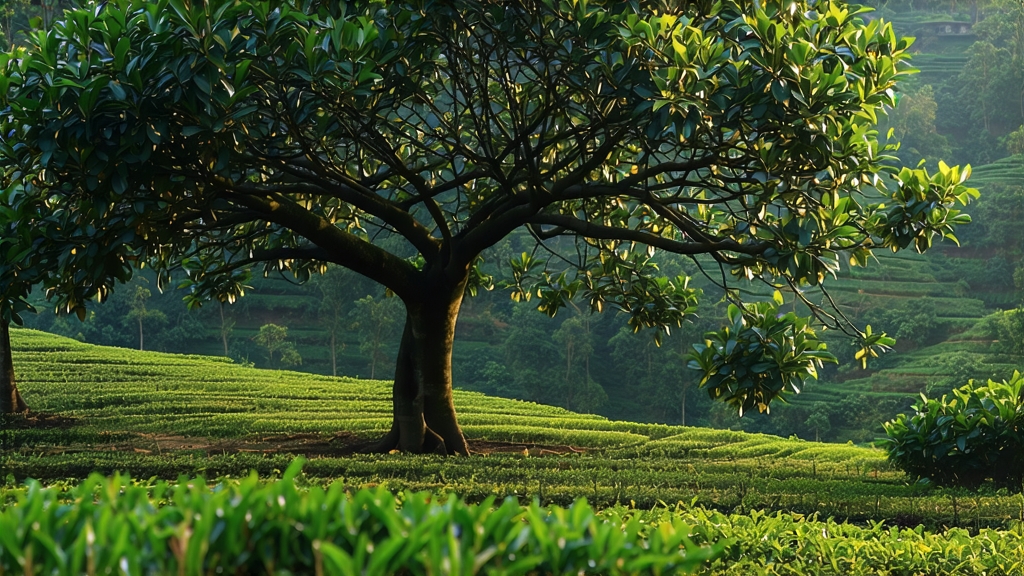
High above the subtropical valleys of Guangdong’s Phoenix Mountain, clouds coil around granite peaks whose mineral-rich soils have nurtured tea gardens for almost a thousand years. It is here, between 350 m and 1,300 m elevation, that Phoenix Dancong—literally “single-bush”—transforms the concept of oolong from a mere beverage into an encyclopaedia of fragrance. Unlike blended teas, each Dancong grove is planted with individual trees so genetically distinct that a single row may yield liquors reminiscent of jasmine, lychee, almond, ginger flower or ripe mango. International drinkers often meet Dancong through its most famous aromatic profile, “Honey Orchid Fragrance” (Mi Lan Xiang), yet this is only one chapter in a living library of over eighty recognised aromatics, each tied to a named mother tree, a micro-valley, and a season.
Historical scrolls from the Song dynasty (960-1279 CE) already praise “Phoenix tribute tea,” but Dancong’s deliberate cultivation as single-tree plots began during the late Ming. Refugees from the north settled on the cooler, fog-shrouded slopes and noticed that seedlings grown from seeds—rather than cuttings—developed wildly different leaf chemistry. By selecting and vegetatively propagating the most aromatic individuals, they created clonal lines that behave like separate grape varietals in wine. The tradition was preserved through Qing-era imperial decrees that exempted mountain villages from grain tax in exchange for tea, and later through the republican period when overseas Chaozhou merchants shipped roasted Dancong to Southeast Asia, embedding it in diaspora tea culture.
Botanically, Dancong belongs to the Feng Huang (Phoenix) cultivar group, a sexually reproducing population of Camellia sinensis var. sinensis. Over centuries, open pollination has produced a gene pool so diverse that neighbouring trees can differ in leaf size, serration, pubescence and, most importantly, volatile terpene composition. Local growers classify these individuals into fragrance types (xiang xing) rather than conventional horticultural cultivars. Well-known profiles include:
- Mi Lan Xiang (Honey Orchid) – peachy top notes with a lingering bass of raw honey.
- Huang Zhi Xiang (Gardenia) – bright, green-floral, slightly creamy.
- Zhi Lan Xiang (Orchid) – delicate, cool, with a snap of green peppercorn.
- Xin Ren Xiang (Almond) – marzipan sweetness balanced by a tannic edge.
- Jiang Hua Xiang (Ginger Flower) – heady, spicy, almost narcotic in the cup.
Because each profile is tied to a specific mother tree, villages keep meticulous maps: Wu Dong, Da An, Shi Gu Ping, Zhong Ping, each name a terroir whispered among collectors like vineyard crus in Burgundy.
Processing Dancong is a choreography of withering, bruising, oxidation and roasting that must respect the individuality of the leaf. The harvest starts at dawn when dew still guards the leaf from mechanical damage. Three to five leaves and a bud are plucked, then solar-withered on bamboo screens for 15–25 minutes to reduce moisture to around 70 %. The leaves are then carried indoors for yaoqing—an intricate 4–6 hour bruising ritual repeated every hour. Hand tossing in round rattan trays ruptures cells, allowing enzymes to meet oxygen and generate floral aromatics; the master listens for the rustle that signals readiness, a sound compared to “mountain crickets at dusk”. Oxidation is arrested at 25–35 % by a 280 °C tumble in a hot wok, hot enough to fix the green yet gentle enough to preserve the fragile monoterpene alcohols responsible for honey and orchid notes.
Rolling follows, first mechanically to twist the leaf, then by hand to tighten the strip. A unique “two-stage roast” distinguishes Dancong from other oolongs. The initial bake at 80–90 °C drives residual moisture down to 5 %, but the critical second charcoal roast (hongbei) occurs weeks later. Using embers of local longan or lychee wood, the tea master buries the leaf in double-walled bamboo baskets for 6–12 hours, repeating the cycle up to three times. Temperature is judged by sprinkling water on the ash—if it dances, the heat is too fierce. This low, radiant heat